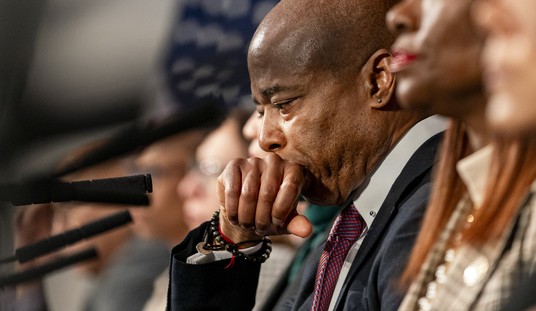Josh Hawley was dismayed when this WSJ story broke last night, vowing to demand answers from the Pentagon.
I look forward to hearing tomorrow in Senate Armed Services why the Pentagon reportedly wants 14,000 MORE troops in the Middle East, after sending 14,000 already this year alone. Is the Pentagon preparing for a land war? https://t.co/sR6AwKXERM
— Josh Hawley (@HawleyMO) December 4, 2019
His numbers are correct. Trump spent many days in October defending his decision to withdraw from northern Syria amid Turkish threats of an invasion on grounds that he was keeping his promise to end America’s otherwise endless wars in the Middle East. That was deceptive even in the context of Syria: Most of the troops who left northern Syria didn’t come home, they were redeployed to Iraq and to Kurdish-controlled oil regions in Syria. But it was especially deceptive from a regional standpoint considering that 14,000 American troops have been sent to the Middle East since May. And now, if you believe the Journal, that number might soon double.
Pentagon spokesman Alyssa Farah tried to tamp down the rumors:
To be clear, the reporting is wrong. The U.S. is not considering sending 14,000 additional troops to the Middle East.
— Alyssa Farah (@PentagonPresSec) December 5, 2019
With all due respect, the only person who knows what the U.S. will or won’t do day-to-day is Trump. The Pentagon is reportedly so wary of surprises from the president that they’ve prepared a plan for rapid withdrawal from Afghanistan just in case Trump comes downstairs from his bedroom some morning and decides that it’s time to go — right this minute. The Syria withdrawal also allegedly took military leaders by surprise. Farah may be giving us her best information about America’s plans are, but who cares what she or Mark Esper or Mark Milley think? They don’t know what’s going on.
Only one person does. And so: 14,000 more troops potentially, per the Journal.
Mr. Trump, facing an election next year, has long sought to exit foreign entanglements and avoid new conflicts. But on Iran—and partly at the behest of Israel—he is convinced of the need to counter the threat his aides say Tehran poses, the officials said. He also could approve a smaller U.S. deployment, the officials said.
There is growing fear among U.S. military and other administration officials that an attack on U.S. interests and forces could leave the U.S. with few options in the region, officials said. By sending additional military resources to the region, the administration would be presenting a more credible deterrent to Tehran, which has been blamed for a series of attacks, including one in September against oil facilities in Saudi Arabia. Iran has denied involvement.
The new U.S. deployment also would be designed as a deterrent against possible Iranian retaliation for mounting sanctions under the administration’s economic-pressure campaign. Some officials worry, however, that adding more military resources to the mix could provoke another attack or put the region on track for a dangerous and unpredictable conflict.
Any reason to think the U.S. should be extra worried about an Iranian provocation right now? Well, per Business Insider, there’s new intel this week that Iran may be planning … something:
“There has been consistent intelligence in the last several weeks,” one administration official told CNN.
A second official described it as information that has been gathered throughout November. The information is being gathered by military and intelligence agencies.
The officials would not say in what format the intelligence exists. But in the last several weeks there has been movement of Iranian forces and weapons that the US worries could be put in place for a potential attack, if one is ordered by the Iranian regime, the officials said. It’s not clear if a potential threat would come from the central government or Iran’s Islamic Revolutionary Guard Corps.
That’s vague, but other outlets have been more specific. Newsweek reported yesterday that Iranian proxies have been conducting drone surveillance near U.S. positions in various spots in the Middle East. The fear is that something’s coming and that “suicide drones,” i.e. drones armed with explosive payloads, may be used as part of an attack. The NYT added last night that Iran has supposedly been moving short-range missiles secretly into Iraq which it could use to target Israel, Saudi Arabia, or U.S. troops directly in case conflict breaks out. Whether the Iranians are fearful that the U.S. is planning something (remember that Trump sent 1,800 more troops to Saudi Arabia just weeks ago) and are hoping to deter it or whether they’re planning another act of aggression like their attack in September on the Kingdom’s oil fields is unclear. But Centcom has been worried about a new Iranian provocation for weeks. And it’s hard to believe Iran would sincerely fear a surprise attack by Trump given how strongly he’s signaled that he wants talks, not war.
To make things even more tense, both Iran and its majority-Shiite neighbor/client Iraq find themselves at fraught moments politically. The latest U.S. estimate of the death toll from the political demonstrations that have shaken Iran’s regime is that it could exceed 1,000 people, a number many times greater than the number killed during the Green Revolution 10 years ago. The mullahs are nervous, squeezed economically by American sanctions and desperate to stamp out the protests before they turn into a revolution. Meanwhile, Iraq’s prime minister just resigned partly due to criticism that Iran had too much influence over Iraq’s Shiite-led government. Qassem Soleimani, the head of the Quds Force, has been in Baghdad this week trying to manage that crisis too before a new round of sectarian warfare breaks out and risks drawing in the Iranians.
Which is to say, you can see why Trump and Centcom might want a new deployment of American soldiers spread out across the region. Iran is a wounded animal, and wounded animals are dangerous and unpredictable. Trump wants Tehran to know that if they decide to lash out at the Saudis or whoever in the hopes that war with a regional enemy might trigger a patriotic impulse that deflates the protests at home, American forces are in position to hit back hard and fast. Of course, given Trump’s frequently stated aversion to conflict, Iran’s task should be simple: Avoid killing Americans and you’re free to hit whoever you like without fear of a U.S. reprisal. Hopefully the troop build-up will intimidate them to the point where they’d rather not test that theory.
How all of this plays with MAGA Nation, though, I don’t know. There are already 60,000-80,000 American troops in the Middle East right now despite Trump’s pledge to “end endless wars.” That number will increase soon. To the average Trump fan, there’s probably no inconsistency in those facts: He will end endless wars, but when a given moment calls for a little muscle-flexing, muscle-flexing is the right thing to do. Ending wars is a long-term goal, not something you do all at once and then let the chips fall where they may. For a more principled nationalist and Iran dove like, say, Tucker Carlson, that argument might not cut it. Anything that increases the risk of war with Tehran is a bad idea. Why are we sending American soldiers to protect a scumbag regime like the Saudis? Why does a military powerhouse like Israel need our help to deter the mullahs? I hope Trump’s prepared for a (small) backlash from some of his loudest cheerleaders.








